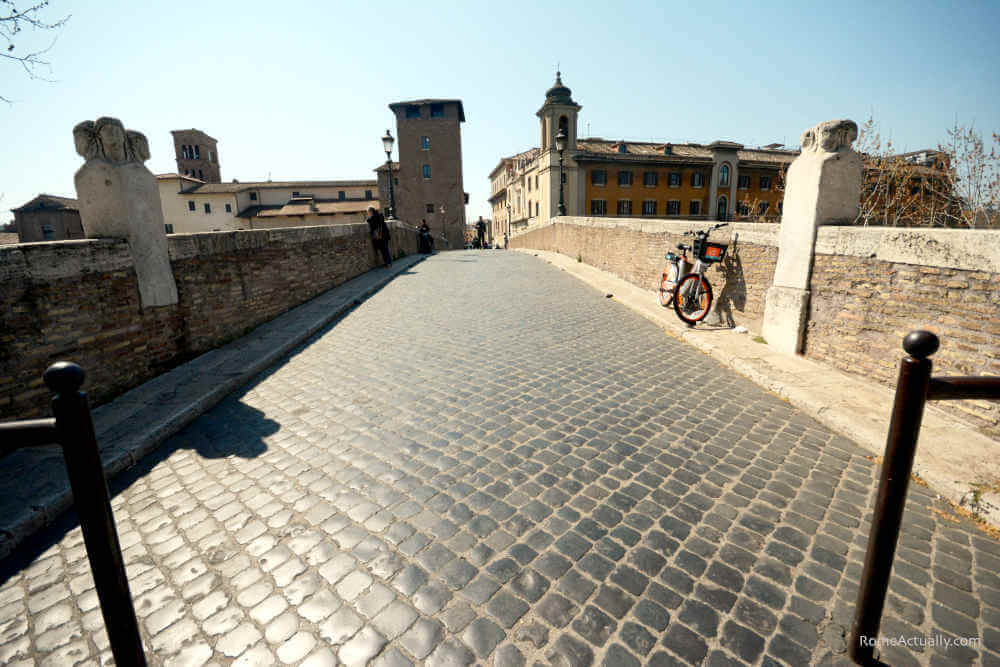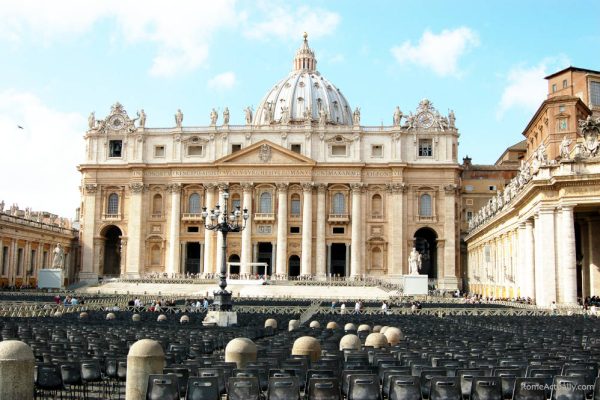The short Ponte Fabricio, Rome’s oldest bridge, is located between the Jewish quarter and the Trastevere neighborhood. It’s one of the two bridges that connect man-made Tiber Island with Rome’s “mainland”. Specifically, the Fabricio bridge connects Tiber Island with the Jewish quarter, while Ponte Cestio is the bridge connecting the island with Trastevere.

Things to Know About Pons Fabricius: Facts and History
- Probably replacing a former wooden bridge, Pons Fabricius takes its name from Lucio Fabricius who first commissioned it in 62 BC, who was also the person in charge of taking care of the roads (“curatum viarium”).
- Ponte Fabricio bridge is to be considered the oldest in Rome if we don’t count all the bridges that have been demolished and don’t exist anymore such as the old Ponte Sublicio (that has nothing to do with the current Sublicio bridge connecting Testaccio with the Aventine Hill, Pons Aemilius known as Ponte Rotto that still stands but it’s not in use anymore, or those that have been almost fully restored after being heavily damaged like Ponte Milvio, the construction of which began in 115 BC.
- Pons Fabricius is 57.30 meters (188 feet) long and 5.60 meters (18 feet) wide.
- The bridge is made of blocks of tuff and peperino, a magmatic rock that Romans used to take from the caves of Marino in the Alban Hills south of Rome. They used to extract the peperino stone from the edges of the volcanic crater where is the lake of Castel Gandolfo. The hardness of peperino rock made it a perfect construction material.
- At some point in history, Pons Fabricius was also called “Lapideus” after Marcus Aemilius Lepidus, the Roman general and statesman member of the Second Triumvirate with Octavianus and Marcus Aurelius, who restored it in 21 BC after the big flood of 23 BC.
- Ponte Fabricio bridge is also called “ponte quattro capi” because of the two four-faced herms of Janus placed on both parapets. According to the legend, the faces represent the architects who restored the bridge: apparently, after the works were completed, Pope Sixtus V Peretti ordered their beheading because of their shameful behavior.
- At the beginning of the 11th century, the Caetani tower overlooking the bridge became shelter for many people, including Pope Victor III in 1078 together with Matilda of Canossa, and Pope Urban II in 1088, also known as Odo of Châtillon and gone down in history as one of the greatest popes and the one who started the Crusades.
- When Vitiges king of the Goths besieged Rome in 537 and severed the aqueducts, all the mills of the Janiculum Hill were transferred to the Tiber Island because the water pressure was stronger than in other parts and worked here until the heavy flood of 1870. The tendency to be covered with sand of the left bank of the Tiber and the presence of the mills and old ruins led to envision a complete demolition of the area, including Pons Fabricius and probably Tiber Island. Thankfully, the project was never implemented otherwise we would have never seen such a charming corner of Rome.
- In ancient Rome, Pons Fabricius was a favorite place especially by common people to commit suicide by throwing themselves into the river. We know this thanks to the Roman poet Horatius who, himself, tried to put an end to his life here but was rescued by his friend philosopher Stertinio.

Find out our suggestions on how to explore Rome for free!
What to See and Do in Ponte Fabricio Bridge
Ponte Fabricio is a small bridge but it has a few features worth noticing.
- The Ponte Fabricio bridge owes its existence to Lucio Fabricius and the first thing you should notice arriving from the city center is the large inscription carved on the bridge itself that reminds us of this: L(UCIUS) FABRICIUS C(AI) F(ILIUS) CUR(ATOR) VIAR(UM) FACIUNDUM COERAVIT, Latin for “Lucius Fabricius, son of Claudius and roads’ curator, made build”.
- When arriving, on the main central pylon that supports the large vaults, you can see a small arch: its purpose was to decrease the water pressure in case of a flood.
- Pons Fabricius is one of the pedestrian bridges in Rome: enjoy a small history-rich stroll along its cobbled pavement.
- See the four-faced herms of the god Janus on both sides that were placed here in 1849.
- See the inscription at the end on Tiber Island that testifies to the restoration carried out by Pope Innocent XI Odescalchi in 1679 when he replaced the balustrades with the current fence and the original travertine coating with the current one in brickwork.
- See the Caetani tower at the end of the bridge on Tiber Island, once a refuge for popes and patricians, that is also called “Torre della Pulzella” (Girl’s Tower) because of the engraved face of a girl on one of the sides.

Make sure you read our tips on how to spend 4 perfect days in Rome.
What to See and Do Near Pons Fabricius Bridge
Fabricius bridge is located in a lovely area of Rome so once you get here, you can enjoy plenty of landmarks to explore and discover great places to eat.
- Take a tour of Tiber Island. Pons Fabricius is a beautiful way to get into the charming place that is Tiber Island where you can visit historical landmarks and enjoy a great traditional meal at Sora Lella trattoria.
- See Cestio bridge. From Ponte Fabricio bridge, cross Tiber Island and reach the other historic bridge of the area, Pons Cestius built between 46 and 44 BC by Roman politician Lucius Cestius.
- Explore Trastevere. If you are walking along the river from the city center, crossing both Pons Fabricius and Pons Cestius bridges, you can explore Trastevere neighborhood, packed with fantastic landmarks to visit.
- Stroll around the Jewish Ghetto. The Jewish Quarter starts right at the end of Ponte Fabricius bridge and is an extremely interesting area of Rome to explore. Visit its Synagogue and Jewish Museum, walk around its alley to know more about Jewish culture in Rome, and enjoy a fantastic local Kosher meal.
- Visit the archaeological site of Portico di Ottavia. Apart from its modern sights, the Jewish Ghetto is also home to the fascinating ancient site of Portico di Ottavia.
- Reach the ancient site of Teatro Marcello. One of the most famous archaeological sites in Rome, Teatro Marcello was built in the 1st century in the ancient Forum Flaminio by Julius Caesar and completed by Augustus in 13 BC.
WANT TO READ IT LATER? PIN IT TO YOUR BOARD!





